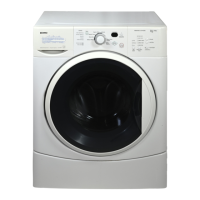18
Common Washing Problems, continued
Many washing problems involve poor soil and stain removal, residues of lint and scum, and fabric damage. For satisfac-
tory washing results, follow these suggestions provided by The Soap and Detergent Association.
PROBLEM POSSIBLE CAUSES SOLUTIONS PREVENTIVE MEASURES
Blue stains Undiluted liquid detergent or •
fabric softener dispensed directly
onto fabric.
If caused by detergent, mix 1 cup (240 •
ml) white vinegar with 1 quart (.95 L)
water in a plastic container. Soak item 1
hour. Rinse.
If caused by fabric softener, rub stains •
with bar soap. Wash.
Avoid overfi lling detergent and •
fabric softener compartments
of dispenser.
Discoloration,
graying
Not enough detergent. •
Wash water temperature too low.•
Incorrect sorting.•
Rewash with correct amount of deter-•
gent and hottest water safe for fabric.
Add bleach safe for fabric.•
Sort items by soil level and •
color.
Use correct amount of deter-•
gent, hottest water and bleach
safe for fabric.
Greasy, oily
stains
Not enough detergent.•
Undiluted liquid fabric softener •
poured directly on fabric.
Treat with prewash stain remover or •
liquid detergent.
Increase detergent and water tempera-•
ture. Rewash.
Rub fabric softener stains with bar soap.•
Use correct amount of deter-•
gent and hottest water safe for
fabric.
Do not pour liquid fabric •
softener directly on fabric. See
Operating Your, step 5.
Holes, tears, or
snags
Incorrect use of chlorine bleach.•
Unfastened zippers, hooks, buck-•
les.
Rips, tears and broken threads.•
Overloading the washer.•
Degradation of fabric.•
May be irreversible if rips, tears and •
seams cannot be mended.
Never pour chlorine bleach •
directly on fabric.
Check condition of items •
before washing. See Operating
Your, steps 2 and 5.
Lint Incorrect sorting.•
Tissues left in pocket.•
Overloading the washer.•
Not enough detergent.•
Undissolved detergent has left a •
residue resembling lint.
Static cling is attracting lint.•
Load washed too long.•
Reduce load size. Rewash using correct •
water temperature, water level, and
amount of detergent.
Add nonprecipitating water conditioner •
to wash water to remove detergent
residue.
Add liquid fabric softener to fi nal rinse.•
Dry load in dryer.•
Remove lint with lint brush or roller.•
See Operating Your, steps 1 •
and 2.
Do not overload washer.•
Use correct temperature and •
amount of detergent, water
and wash time.
Pilling
(Fibers ball up
and cling to
fabric.)
Pilling is normal with synthetic and •
permanent press fabrics. This is
due to abrasion from normal wear.
Use a lint brush or shaver to remove pills.• Use fabric softener in the •
washer to lubricate fi bers.
When ironing, use spray starch •
or fabric fi nish on collars and
cuffs.
Turn items inside out to reduce •
abrasion.
Residue or
powder on dark
items;
Stiff, harsh
fabrics.
Undissolved detergent.•
Some granular detergents can •
combine with hard water minerals
to form a residue.
Overloading the washer.•
Rewash load.• Increase water temperature •
using hottest water safe for
fabric.
Do not overload washer.•
Use liquid detergent or use •
nonprecipitating water condi-
tioner with powder detergent.
Wrinkling Overloading the washer.•
Incorrect wash cycle for wash •
load.
Reduce load size.•
Rinse in cold water with liquid fabric •
softener using the casual or delicate
cycle.
Do not overload washer.•
Remove items from washer as •
soon as cycle is completed.
Use liquid fabric softener.•

